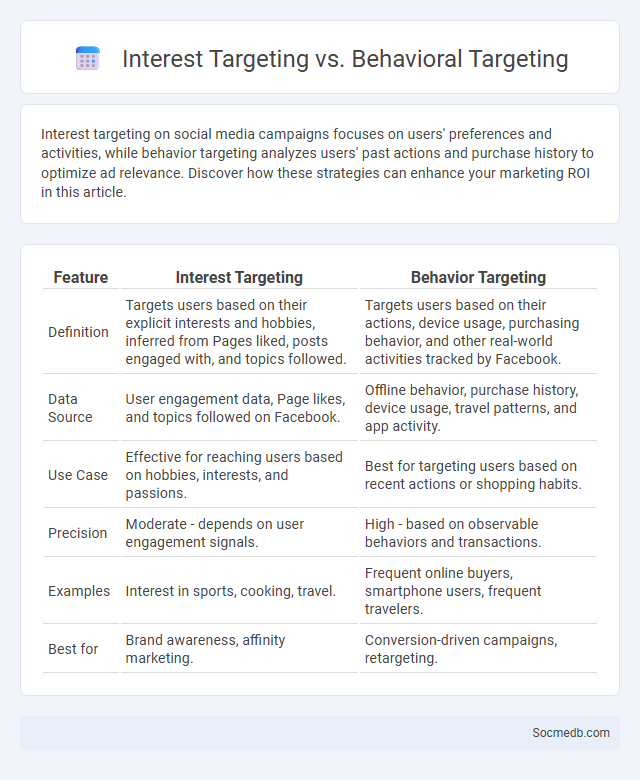
Photo illustration: Interest Targeting vs Behavior Targeting
Interest targeting on social media campaigns focuses on users' preferences and activities, while behavior targeting analyzes users' past actions and purchase history to optimize ad relevance. Discover how these strategies can enhance your marketing ROI in this article.
Table of Comparison
| Feature | Interest Targeting | Behavior Targeting |
|---|---|---|
| Definition | Targets users based on their explicit interests and hobbies, inferred from Pages liked, posts engaged with, and topics followed. | Targets users based on their actions, device usage, purchasing behavior, and other real-world activities tracked by Facebook. |
| Data Source | User engagement data, Page likes, and topics followed on Facebook. | Offline behavior, purchase history, device usage, travel patterns, and app activity. |
| Use Case | Effective for reaching users based on hobbies, interests, and passions. | Best for targeting users based on recent actions or shopping habits. |
| Precision | Moderate - depends on user engagement signals. | High - based on observable behaviors and transactions. |
| Examples | Interest in sports, cooking, travel. | Frequent online buyers, smartphone users, frequent travelers. |
| Best for | Brand awareness, affinity marketing. | Conversion-driven campaigns, retargeting. |
Introduction to Digital Ad Targeting
Digital ad targeting leverages algorithms and user data to deliver personalized advertisements across social media platforms, enhancing relevance and engagement. By analyzing your browsing behavior, interests, demographics, and online interactions, platforms can identify specific audience segments to display tailored ads. This precision targeting maximizes ad spend efficiency and boosts conversion rates by connecting your brand with the right users at the right time.
What Is Interest Targeting?
Interest targeting is a social media advertising technique that allows marketers to reach audiences based on users' specific interests, hobbies, and behaviors identified through their online activity. Platforms like Facebook, Instagram, and LinkedIn use algorithms to analyze user data and categorize interests, enabling advertisers to deliver highly relevant content to potential customers. By leveraging interest targeting, businesses can improve ad engagement, boost conversion rates, and enhance overall campaign effectiveness through precise audience segmentation.
What Is Behavior Targeting?
Behavior targeting is a digital marketing strategy that uses data collected from users' online activities to deliver personalized advertisements on social media platforms. By analyzing browsing history, search queries, and interaction patterns, advertisers create profiles that predict user preferences and interests. This technique enhances ad relevance, increases engagement rates, and improves ROI for social media campaigns by reaching the most likely consumers.
Defining Target Audience
Identifying the target audience on social media involves analyzing demographics, interests, and online behaviors to tailor content effectively. Using tools like audience insights and engagement analytics helps refine messaging for maximum relevance and impact. Clear definition of target audience boosts conversion rates and optimizes advertising budgets across platforms.
Key Differences: Interest vs Behavior Targeting
Interest targeting on social media focuses on your audience's hobbies, preferences, and activities based on their expressed likes, ensuring ads align with what they care about. Behavior targeting analyzes users' past actions, such as purchase history or device usage, to serve more precise advertisements tailored to their habits. Understanding these key differences helps you optimize your ad campaigns for higher engagement and conversion rates.
Benefits of Interest Targeting
Interest targeting on social media enables advertisers to connect with specific audience segments based on their hobbies, preferences, and online behavior, resulting in higher engagement rates. This precise targeting reduces ad spend waste by delivering content to users most likely to respond positively, improving overall campaign return on investment (ROI). Brands benefit from enhanced customer insights and the ability to tailor messaging, creating more relevant and impactful interactions.
Benefits of Behavior Targeting
Behavior targeting on social media enhances your advertising efficiency by delivering highly relevant content to users based on their browsing habits, interests, and demographics. This increases engagement rates and conversion by connecting with audiences whose behavior indicates a genuine interest in your products or services. Personalized ads not only improve user experience but also maximize your return on investment by reducing wasted impressions and clicks.
How to Identify Your Target Audience
Identifying your target audience on social media involves analyzing demographics, interests, and behaviors to tailor content that resonates. Use platform analytics tools like Facebook Insights or Instagram Analytics to gather data on user engagement and preferences. By understanding your audience's needs and preferences, you can optimize your social media strategy to increase reach and conversion rates effectively.
Choosing the Right Targeting Strategy
Choosing the right targeting strategy on social media involves analyzing your audience's demographics, interests, and online behavior to create highly personalized campaigns. Leveraging data from platforms like Facebook Ads Manager and Instagram Insights helps you refine your approach, ensuring your content reaches users most likely to engage and convert. Optimize your budget by continuously testing and adjusting targeting parameters to maximize ROI and growth for your business.
Conclusion: Maximizing Campaign ROI
Maximizing campaign ROI on social media requires precise audience targeting, consistent performance analysis, and strategic budget allocation across platforms like Facebook, Instagram, and LinkedIn. Leveraging data-driven insights and A/B testing enhances ad relevance and engagement, directly boosting conversion rates and reducing cost per acquisition. Integrating automation tools and influencer partnerships further strengthens campaigns, delivering sustainable growth and measurable returns.
 socmedb.com
socmedb.com